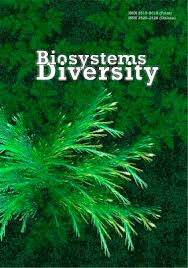Diversity and dynamics of hydrophilic flora of Lowland Polissya (on the example of the Sluch River basin)
Diversity and dynamics of hydrophilic flora of Lowland Polissya (on the example of the Sluch River basin)
Author(s): Y. Grokhovska, V. O. Volodymyrets, S. KonontsevSubject(s): Agriculture, Energy and Environmental Studies, Regional Geography, Environmental Geography
Published by: Дніпропетровський національний університет імені Олеся Гончара
Keywords: vascular macrophytes; rare species; alien species; the Pripyat River basin;
Summary/Abstract: Study and analysis of hydrophilic flora diversity are important parts of environmental research due to various functions of vascular macrophytes in freshwater ecosystems, which deteriorate under the influence of anthropogenic activity and climate change. The aim of this study is to analyze the hydrophilic flora diversity (taxa, biology, ecology, and conservation status of species) and current population trends in the Sluch River basin, the largest tributary of the Horyn River (the Pripyat River basin), within the Polissya Lowland in the northern-west region of Ukraine. The list of hydrophilic flora is based on materials of the authors’ field researches in 2014-2020 within the upper and middle parts of the river basin, herbarium materials, and archive data. The study shows that the natural flora consists at least of 105 species of vascular plants belonging to 66 genera, 36 families, and 22 orders. Structural analysis shows the predominance of a few families in the systematic structure of the flora (Cyperaceae, Potamogetonaceae, Poaceae, Ranunculaceae, Plantaginaceae, and Typhaceae) and genera (Potamogeton, Carex); the dominant categories are hemicryptophytes and geophytes, entomophiles and anemophiles, heliophytes and hygrohelophytes. C- and S-strategists are dominant. This is the generally typical taxonomic and ecological structure of the hydrophilic flora of water bodies in the Pripyat River basin. The list of rare species includes 20 species from 15 genera and 12 families, for instance, species listed as vulnerable in The Red Book of Ukraine (Juncus bulbosus, Utricularia intermedia, Nymphoides peltata). Even rare and vulnerable species can form numerous populations in some localities, for example, Nymphoides peltata and Calla palustris. Five alien species were identified (Acorus calamus, Elodea canadensis, Zizania latifolia, Bidens frondosa, and Echinocystis lobata), some of which tend to expand and displace aboriginal species. In the future, it will be important to further study the structure and changes in the hydrophilic flora of the region under conditions of anthropogenic impact, to monitor the dynamics of populations of alien species, and to develop conservation measures for rare species and communities.
Journal: Biosystems Diversity
- Issue Year: 29/2021
- Issue No: 3
- Page Range: 303-310
- Page Count: 8
- Language: English

